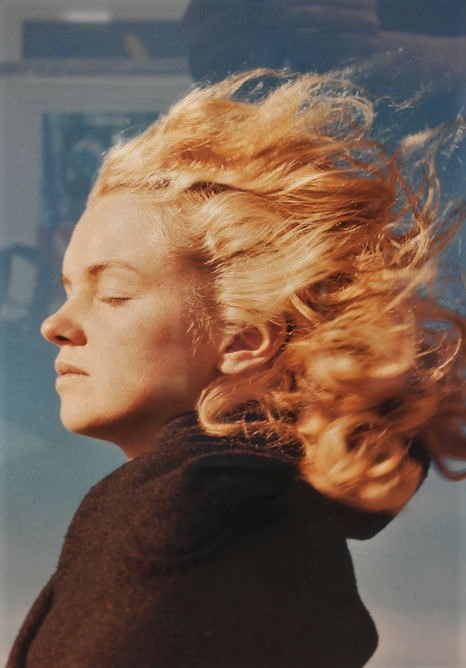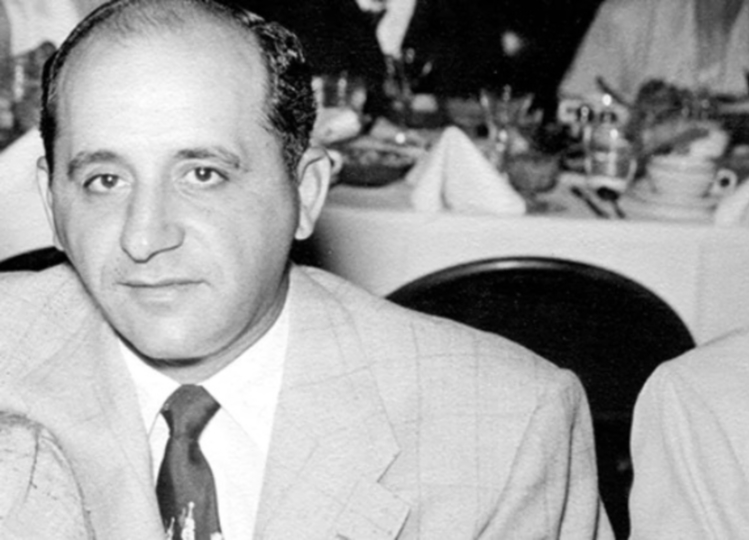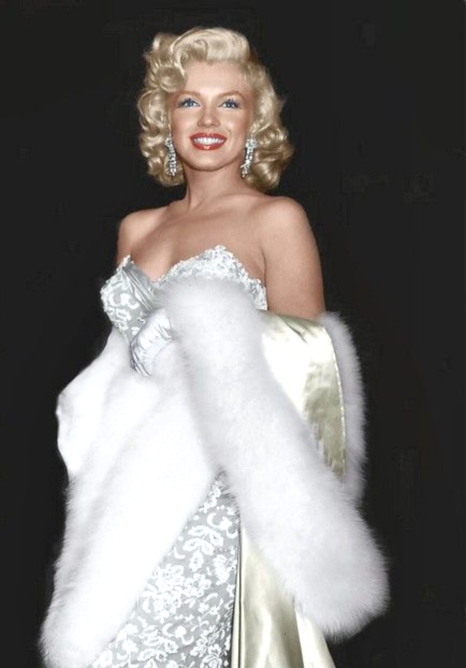The Kennedy Affair Document
During 2012, the FBI reprocessed and posted on their website, thereby making them available for download, eighty-five pages of previously released documents pertaining to Marilyn Monroe, the main benefit of which was a considerable improvement of the copy quality and some redaction removal. One such document was the curiosity entitled Robert F. Kennedy, which I hereafter call the Kennedy Affair Document or often abbreviate KAD. First, the actual document:
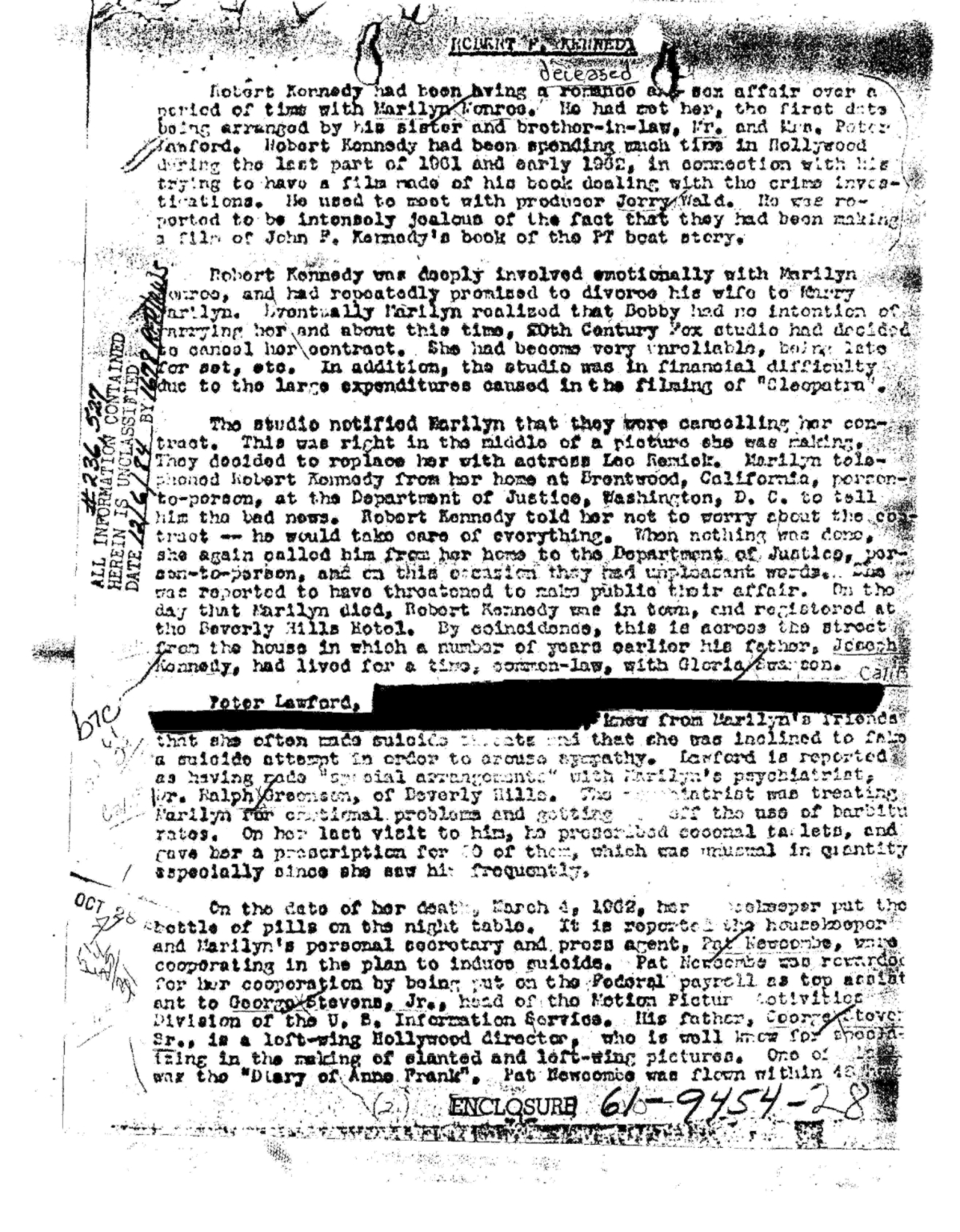
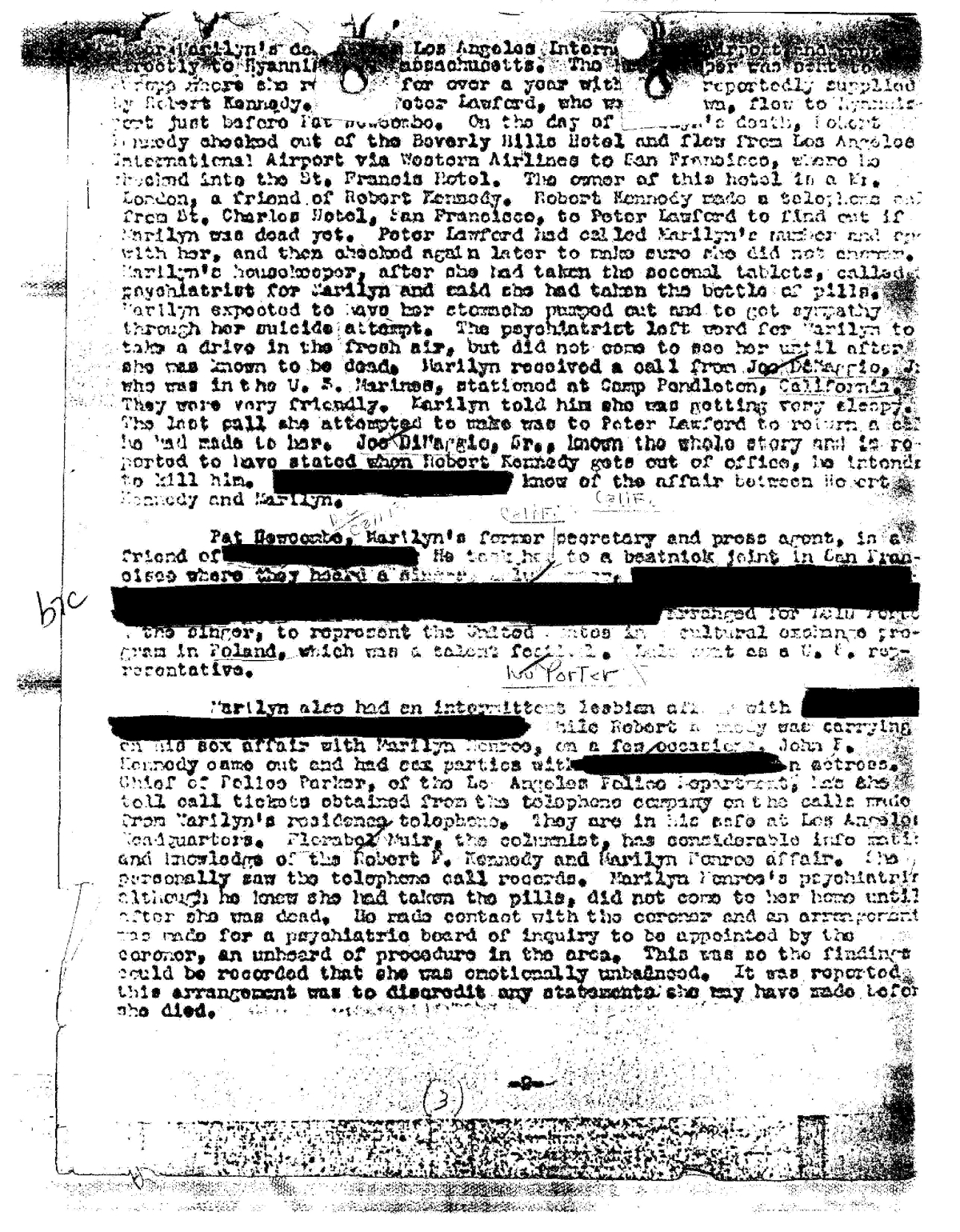
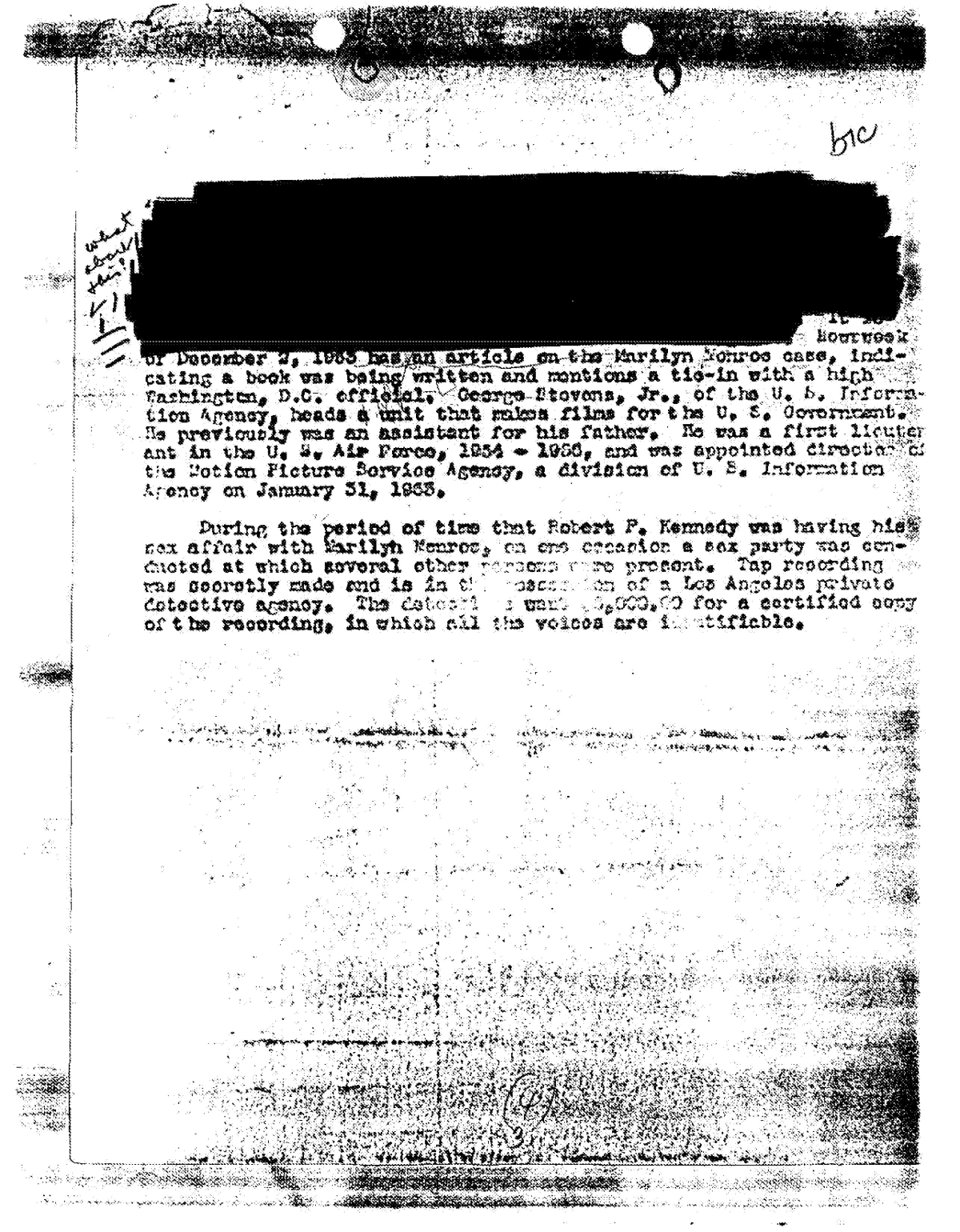
Transcribed text of the preceding unusual document follows hereafter. My suggestions for various redactions, concealed and/or illegible words, possibly phrases, within the text of the document, those which seemed fairly obvious, that is, I have italicized within brackets; but admittedly, they might not be correct. For the nonobvious ones, I have offered no suggestions. I have repeated the document as written, including misspelled words.
Robert F. Kennedy
Robert Kennedy had been having a romance and sex affair over a period of time with Marilyn Monroe. He had met her, the first date being arranged by his sister and brother-in-law, Mr. and Mrs. Peter Lawford. Robert Kennedy had been spending much time in Hollywood during the last part of 1961 and early 1962, in connection with his trying to have a film made of his book dealing with the crime investigations. He used to meet with producer Jerry Wald. He was reported to be intensely jealous of the fact that they had been making a film of John F. Kennedy’s book of the PT boat story.
Robert Kennedy was deeply involved emotionally with Marilyn Monroe and repeatedly promised to divorce his wife to marry Marilyn. Eventually Marilyn realized that Bobby had no intention of marrying her and about this time, 20th Century Fox had decided to cancel her contract. She had become very unreliable, being late for set, etc. In addition, the studio was in financial difficulty due to the large expenditures caused in the filming of “Cleopatra”.
The studio notified Marilyn that they were cancelling her contact. This was right in the middle of the picture she was making. They decided to replace her with actress Lee Remick. Marilyn telephoned Robert Kennedy from her home at Brentwood, California, person-to-person, at the Department of Justice, Washington, D.C. to tell him the bad news. Robert Kennedy told her not to worry about the contract―he would take care of everything. When nothing was done, she called again from her home to the Department of Justice, person-to-person, and on this occasion they had unpleasant words. She was reported to have threatened to make public their affair. On the day that Marilyn died, Robert Kennedy was in town, and registered at the Beverly Hills Hotel. By coincidence, this is across the street from the house in which a number of years earlier his father, Joseph Kennedy, had lived for a time, common-law, with Gloria Swanson.
Peter Lawford [lengthy redaction] knew from Marilyn’s friends that she often made suicide threats and that she was inclined to fake a suicide attempt in order to arouse sympathy. Lawford is reported as having made “special arrangements” with Marilyn’s psychiatrist, Dr. Ralph Greenson, of Beverly Hills. The psychiatrist was treating Marilyn for emotional problems and getting her off the use of barbiturates. On her last visit to him, he prescribed seconal tablets, and he gave her a prescription for [illegible] of them, which was unusual in quantity since she saw him frequently.
On the date of her death, March 4, 1962, her housekeeper put the bottle of pills on the night table. It is reported the housekeeper and Marilyn’s personal secretary and press agent, Pat Newcombe, were cooperating in the plan to induce suicide. Pat Newcombe was rewarded for her cooperation by being put on the Federal payroll as top assistant to George Stevens, Jr., head of the Motion Picture Activities Division of the U.S. Information Services. His father, George Stevens, Sr., is a left-wing Hollywood director, who is well known for specializing in the making of slanted and left-wing pictures. One of [the pictures] was the “Diary of Anne Frank”. Pat Newcombe was flown within 48 hours after Marilyn’s death from Los Angeles International Airport directly to Hyannisport, Massachusetts. The helicopter was sent to [words obscured by clips] where she [resided] for over a year with [money] reportedly supplied by Robert Kennedy. [Pat and] Peter Lawford, who [words obscured] flew to Hyannisport just before Pat Newcombe. On the day of Marilyn’s death, Robert Kennedy checked out of the Beverly Hills Hotel and flew from Los Angeles International Airport via Western Airlines to San Francisco, where he checked into the St. Francis Hotel. The owner of this hotel is a Mr. [illegible] London, a friend of Robert Kennedy. Robert Kennedy made a telephone call from St. Charles Hotel, San Francisco, to Peter Lawford to find out if Marilyn was dead yet. Peter Lawford had called Marilyn’s number and [talked] with her, and then checked again later to make sure she did not [illegible]. Marilyn’s housekeeper, after she had taken the seconal tablets, called psychiatrist for Marilyn and said she had taken the bottle of pills. Marilyn expected to have her stomache pumped out and to get sympathy through her suicide attempt. The psychiatrist left word for Marilyn to take a drive in the fresh air, but he did not come to see her until after she was known to be dead. Marilyn received a call from Joe DiMaggio, Jr., who was in the U.S. Marines, stationed at Camp Pendleton, California. They were very friendly. Marilyn told him she was getting very sleepy. The last call she attempted to make was to Peter Lawford to return a call he had made to her. Joe DiMaggio, Sr., knows the whole story and is reported to have stated when Robert Kennedy gets out of office, he intends to kill him. [Redacted] knew of the affair between Robert Kennedy and Marilyn.
Pat Newcombe, Marilyn’s former secretary and press agent, is a friend of Pierre Salinger. He took her to a beatnik joint in San Francisco where they heard a singing [illegible and a lengthy redaction] arranged for [Lulu Porter] the singer, to represent the United States in a cultural [illegible] program in Poland, which was a talent [illegible]. [Lulu went] as a U.S. representative.
Marilyn also had an intermittent lesbian affair with [redacted]. While Robert Kennedy was carrying on his affair with Marilyn Monroe, on a few occasions, John F. Kennedy came out and had sex parties with [the deceased] actress. Chief of Police Parker, of the Los Angeles Police Department, [possesses the] toll call tickets obtained from the telephone company on the calls made from Marilyn’s residence telephone. They are in his safe at Los Angeles Headquarters. Florabel Muir, the columnist, has considerable information and knowledge of the Robert F. Kennedy and Marilyn Monroe affair. She personally saw the telephone call records. Marilyn’s psychiatrist, although he knew she had taken the pills, did not come to her home until after she was dead. He made contact with the coroner and an arrangement was made for a psychiatric board of inquiry to be appointed by the coroner, an unheard of procedure in the area. This was so the findings could be recorded that she was emotionally unbalanced. It was reported this arrangement was to discredit any statements she may have made before she died.
In Newsweek of August 19, 1963, there appears an article on Pierre Salinger and [Lulu] Porter. Robert Kennedy’s friend, Mr. London, the owner of the St. Francis Hotel, has a brother who is a Communist Party member. He is a millionaire and head of the Crab Industry in Alaska. He is a member of the International Fisheries Commission made up of representatives of the U.S., USSR and Japan. He has a fleet of fishing boats, some of which are equipped with special electronic equipment not necessary for fishing. It is suspected that he does work for Soviet Naval Intelligence. Newsweek of December 2, 1963 has an article on the Marilyn Monroe case, indicating a book was being written and mentions a tie-in with a high Washington D.C. official. George Stevens, Jr., of the U.S. Information Agency, heads a unit that makes films for the U.S. Government. He previously was an assistant for his father. He was a first lieutenant in the U.S. Air Force, 1954–1958, and was appointed director of the Motion Picture Service Agency, a division of U.S. Information Agency on January 31, 1963.
During the period of time that Robert F. Kennedy was having his sex affair with Marilyn Monroe, on one occasion a sex party was conducted at which several other persons were present. Tap recording was secretly made and is in the possession of a Los Angeles private detective agency. The [detective wants $5,000.00] for a certified copy of the recording, in which all the voices are identifiable.
The preceding account is obviously a brief biographical narrative of Robert Kennedy’s alleged romantic relationship with Marilyn Monroe, resulting in a sinister plot to induce her suicide. Several questions about the account must be asked. When was it written? Who wrote it? Why did the author deem it necessary to write such an account involving Marilyn and Robert Kennedy virtually two years after Marilyn’s death? Why did the author mention former President John Kennedy, who had been publicly assassinated approximately one year earlier? Is the information presented in the document accurate? More importantly, perhaps, is the information presented in the document even credible?
A cover page preceded the KAD, imprinted with the following notification:
Enclosed is an item received from [redacted] former Special Agent, who is currently Field Representative, Appointment Section, Governor’s Office, State of California. [Redacted] advised that he does not know the source and cannot evaluate the authenticity of this information.
This cover page was also imprinted with a stamp of declassification, which occurred on the 6th of December in 1984, initialed by RFP/RWS, designated number 236,527, along with the designated file number 61-9454-82. Beneath the declassification stamp, a person printed the following words:
FROM SAC LYNUM
SAN FRANCISCO
RECD 10-19-64
The document was also stamped with the date of OCT 23 1964.
The initials SAC are an FBI acronym for Special Agent in Charge; and the word LYNUM, without question, refers to Special Agent Curtis O. Lynum.
After twenty-two years as an FBI agent, Lynum was promoted to the position of Special Agent in Charge of the San Francisco field office in 1963. He functioned in that role until he retired in 1967. That year, along with his top domestic security agent, Glenn A. Harter, Lynum met with the newly elected California governor, Ronald Reagan. At the time, campus unrest at UC Berkeley was accelerating, intensifying and threatening to spread around the nation. Reagan requested the FBI’s assistance with an effort to quell that unrest. Hoover sent Lynum, who admired both Reagan and the FBI’s director, to the Governor’s mansion. Reagan did not know at that time, but he would soon learn, that Hoover had already engaged his powerful bureau in a covert and extensive intelligence gathering operation on the Berkeley campus. Lyman was also involved in that operation. He gathered intelligence and generated lengthy dossiers on the dissidents, along with faculty members and the university’s president, who had not yet moved to stop the protester’s disruptions. Lynum explained the situation at the university to Reagan; then afterwards, Lynum transmitted a written report assessing his meeting with the governor to Hoover. As the director usually did in virtually every situation involving protests against authority, he saw an opportunity to deal with Communist subversives.
Not long after he met with Reagan and filed his report, Lynum retired from Hoover’s FBI. During his retirement, he wrote two autobiographical books. In 1988, he published The FBI and I; and in 2003, he published The FBI Wife: Special Agent in Charge–FBI, an odd title which suggested that Lynum viewed his career in the FBI like a marriage.
Apparently, a former Special Agent attached to the Governor’s office in Sacramento received the Kennedy Affair Document which he or she then transmitted to San Francisco from where Curtis Lynum then transmitted it to Washington, DC, to both Hoover and Hoover’s assistant, Clyde Tolson. Even though the cover page clearly indi-cated that the former Special Agent who had received the information disavowed any knowledge of the source’s credibility or the story’s validity, the KAD was included in Marilyn’s FBI File. Therefore, two additional questions arise. Why was the disavowed document included in Marilyn’s FBI file; and how should we evaluate not only what the document asserts, but the actual physical document itself?
To begin with, the document does not look like any other FBI file, memorandum or report of which I am aware or with which I am familiar. FBI documents from the fifties and the sixties usually followed a similar prescribed format, which identified the document as a work product of the FBI and appeared on preprinted letterheads or preprinted forms which displayed the words Office Memorandum, United States Government or The Federal Bureau of Investigation. Also, most of the documents are dutifully marked SECRET or even TOP SECRET, CONFIDENTIAL or FOR EYES ONLY. Those indications are missing from the KAD. It’s heading only identifies the document’s subject: ROBERT F. KENNEDY. Certainly, variations between FBI documents occasionally occurred; but the Kennedy Affair Document appears to be an anomaly.
FBI documents involving Marilyn and those in her immediate orb commonly contained inaccuracies and contradictions. The KAD is no different. I recognize that I am evaluating the document’s contents through the prism of history, five decades worth of history; and I additionally recognize that the inaccuracies therein are esoteric and a few even approach the arcane. A few are also humorous.
For instance, according to the KAD, Eunice Murray placed the bottle of Seconal pills on the night table, additional suicide inducement we are certainly led to conclude, additional inducement combined with Robert Kennedy’s alleged rejection of the actress. Marilyn then immediately ingested the entire bottle of Seconal, quantity unknown.
Telephone calls then flew back and forth between Robert Kennedy, now at the St. Francis Hotel in San Francisco, Peter Lawford, standing suicide watch in Santa Monica, and Marilyn in Brentwood, induced to commit suicide. Robert Kennedy telephoned Lawford to confirm that Marilyn was, in fact, dead; and Peter Lawford telephoned Marilyn to confirm that she was, in fact, dead. Mrs. Murray telephoned Dr. Greenson for Marilyn to announce that she had ingested the entire bottle of pills. Apparently, all was going according to the conspirator’s unholy plan. Dr. Greenson, of course, had deceived Marilyn into believing that he was going to save her from the embrace of death, which would engender sympathy; but Dr. Greenson only responded to Eunice’s telephone pill ingestion announcement by suggesting that Marilyn should take a drive in the fresh air.
Joe DiMaggio, Jr. then telephoned and Marilyn told him she was getting very sleepy. I’ll bet she certainly was. Apparently, after being very friendly with Joe DiMaggio, Jr., Marilyn attempted to return Lawford’s telephone call, unsuccessfully we are led to assume; and what was the purpose for noting that Marilyn was very friendly with the junior DiMaggio, an editorial comment with certain sexual overtones. Why would Marilyn be anything but friendly with her former stepson?
The KAD then noted that Dr. Greenson came to Marilyn’s hacienda only after she was dead, after the plot had succeeded, after Marilyn’s suicide had been successfully induced by Dr. Greenson, Eunice Murray, Peter Lawford and Pat Newcomb.
Finally, according to the KAD, the senior DiMaggio knew all about Marilyn’s affair with Robert Kennedy, knows the whole story, including the plot to induce her suicide, we are led to assume; and the senior DiMaggio intends to kill the attorney general, but only after the attorney general gets out of office, which, of course, would reduce the severity of that murder and make it less catastrophic for DiMaggio and the Kennedy clan. But then, if Joe DiMaggio knew about the plot to have Marilyn murder herself, certainly he would have acted to prevent Marilyn from doing so; and would he not want to enact some revenge on all involved? I guess not; but then the focus of the KAD was singularly Robert Kennedy.
I must confess that the preceding scheme, as I read the KAD, sounded more and more like the outlined plot of a Marx Brothers movie starring Peter Lawford, Romeo Greenson and Robert F. Kennedy instead of Groucho, Chico and Harpo: the entire nonsensical and harebrained scenario described in the KAD clearly represented a fiction, a goofy politically motivated artifice.
While the KAD indicated that Marilyn overdosed on Seconal, Marilyn’s autopsy report did not mention Seconal, a brand name of secobarbital. The autopsy report only mentioned Nembutal, a brand name of pentobarbital, which was one of the drugs Marilyn ingested on August the 4th that killed her; but then the KAD did not mention Chloral hydrate, a drug that was in Marilyn’s body, according to her autopsy. A fellow wonders why the KAD did not mention Chloral hydrate and how did Nembutal become Seconal?
Additionally, the document’s writer noted that Dr. Greenson prescribed Marilyn an unusually large quantity of Seconal tablets, unusual since she saw him frequently. On July the 19th, seventeen days before her death, Marilyn received a prescription for twenty-five Seconal pills along with an additional one-hundred pills of Librium, fifty pills of Valmid and twenty-five pills of Tuinal. The historical record does not indicate any additional Seconal prescriptions prior to her death. Also, Dr. Hyman Engelberg, her internist, wrote most of her prescriptions, not Dr. Greenson; and considering the quantity of pills prescribed for Marilyn during the weeks leading to her death, a prescription for almost any large quantity of pills would not have been unusual, a topic additionally discussed in Section 14.
The glaring error in the KAD, of course, is Marilyn’s death date, ascribed to March the 4th in 1962, a date incorrect by six months and an error which indicated, if not a certain ignorance regarding Marilyn’s death, most certainly an historical ineptitude. The KAD also alleged that Robert Kennedy was in Los Angeles on the day that Marilyn died and that he was registered at the Beverly Hills Hotel. Was the author of the KAD referring to March the 4th, August the 4th or August the 5th as the day Marilyn died? And too, according to Officer Lynn Franklin, Robert Kennedy was registered at the Beverly Hilton while other testifiers have asserted that the attorney general was staying at Peter Lawford’s beach house during the weekend of Marilyn’s alleged murder. And too, on the night of August the 4th, when Robert Kennedy was allegedly whirly birding his way back to Gilroy, did he just drop into the St. Francis Hotel in San Francisco just to place his inquiring telephone call to Lawford?
Certainly, any person looking for a conspiracy or any person who believed, or believes, that Robert Kennedy was involved in Marilyn’s death will accept verbatim what the document’s author asserted; but the following piece of information, found in paragraph eight, is certainly germane to any evaluation of the KAD: Newsweek of December 2, 1963 has an article on the Marilyn Monroe case, indicating a book was being written and mentions a tie-in with a high Washington D.C. official (emphasis mine).
The preceding is an obvious reference to Frank Capell’s pamphlet, The Strange Death of Marilyn Monroe, published in either late July or early August of 1964. Is it just coincidence that the year the KAD appeared is also the year Frank Capell published his pamphlet, a scathing and politically motivated attack on Robert Kennedy which I discussed and evaluated in Section 3. The attack was an obvious attempt to derail Robert Kennedy’s campaign trains in both 1964 and then also 1968, the first campaign, senatorial, the second campaign, presidential, ended by Robert Kennedy’s assassination. Briefly restated here, Capell’s pamphlet suggested that Marilyn’s death was actually a murder concealed as a suicide and implicated Robert Kennedy in a Communist plot to silence the troubled movie star and Robert Kennedy’s former paramour.
The oddly interesting verb tense of “past progressive, passive voice” employed in the Newsweek article reveals that the composition of the Kennedy Affair Document and Capell’s pamphlet were most certainly concurrent events; and the allegation that the book, which was being written, would mention the involvement of a high Washington D.C. official, an obvious allusion to Robert Kennedy, was nothing less than a preemptive strike, nothing less than an unveiled threat. Since Frank Capell’s pamphlet had yet to be published in December of 1963, then obviously Newsweek obtained the information which appeared in the December article via a strategic leak; and the pertinent question is, leaked by whom? Additionally, the attorney general also received prior notification regarding Capell’s impending publication from none other than J. Edgar Hoover, who must have learned about Capell’s future publication either from Capell himself or Walter Winchell, each Hoover’s pal and each Hoover’s muckraker, just two of many. According to Donald Spoto, Hoover dispatched a letter to Robert Kennedy in which he informed the attorney general that Capell’s pamphlet referenced a putative intimate relationship with Miss Monroe while also asserting that Capell would level the following imputation: Robert Kennedy was with Marilyn and in her home when she died. The attorney general did not reply to Hoover’s letter (Spoto 601-602). More than a thin thread connected Capell’s seventy page pamphlet and the Kennedy Affair Document. A fellow could legitimately argue that the connection was a thick rope manipulated into a noose with which Capell, Winchell and Hoover intended to hang Robert Kennedy.
A fellow could also legitimately argue that the filed document could have functioned as an outline for Capell’s 1964 pamphlet despite the inaccuracies presented therein. Certainly Capell knew that Marilyn did not die in March of 1962; certainly he knew the contents of her autopsy report; and certainly he knew how to spell Pat Newcomb’s last name. Even so, references to Communists, left-wing Hollywood directors and the beatnik Pierre Salinger echoed the language and the sentiments expressed by Capell within the text of his 1964 pamphlet. A Communist murder arranged to look like a suicide, faked suicide attempts to garner sympathy, Marilyn’s experimentation with Lesbianism late in her life, an imputation that Pat Newcomb was Marilyn’s lover, since Pat did not harbor any romantic ideations regarding men, were all advanced by Capell within the text of his thin philippic; and like the text of the KAD, Capell suggested that each and every one of Marilyn’s evil and depraved Communists associates participated in the suicide conspiracy and each was appropriately rewarded financially by the middle Kennedy brothers and the Kennedy clan of VIPs.
Due to the obvious inaccuracies in the Kennedy Affair Document and since Capell was a known operative for the FBI, I am going to stop short of alleging that he actually wrote the KAD but suggest that Capell certainly played a part in its composition, even if indirectly. However, the use of one unusual phrase to describe the relationship between Marilyn and Robert Kennedy, significantly appeared in both Capell’s pamphlet and the KAD, the phrase sex affair. I have encountered that descriptive phrase in only two locations: The Kennedy Affair Document and Capell’s The Strange Death of Marilyn Monroe.
Why did the author include John Kennedy within the text of the KAD? Doing so functions simply and primarily as a post-assassination assassination of the former president by implicating him in Marilyn Monroe’s alleged murder. Being an incorrigible philanderer is one thing but being a man who was willing to murder his mistress represented a grim character assassination that J. Edgar Hoover more than likely found gratifying, just like ensuring that all the requisite leaks of the contents of Capell’s pamphlet found their way into the hands of the appropriate persons and publications, just like he ensured that the strange and defamatory KAD ended up in Marilyn’s FBI file, ended up, therefore, as a part of the historical record. FBI file 61-9454-82 speaks directly to the intentions of Frank Capell, Walter Winchell and J. Edgar Hoover, possibly even Curtis O. Lynum. The odd and dubious Kennedy Affair Document has evidentiary value in that regard and only in that regard.
A few additional points. Pat Newcomb was not Marilyn’s personal secretary; that role was filled alternately by Cherie Redmond and Inez Melson. The imputation that Pat received her government job simply because she assisted Robert Kennedy’s suicide plot did not, and does not, have any factual basis nor substantiating evidentiary proof. Actually, Pat applied for the job with information services. Frank Capell even published her application in his pamphlet. Furthermore, Pat did not begin receiving her alleged reward until May of 1963, seven months after Marilyn’s death. Additionally, regarding Pierre Salinger, Pat later worked on his unsuccessful senatorial campaign in 1964 after which she became a consultant to the Justice Department, which, of course, clearly implicated her in Robert Kennedy’s suicide plot and Marilyn’s death―at least that is, in the conspiracist’s odd universe. The assertion that Marilyn’s suicide attempts were simply stunts to gain sympathy also appeared in Capell’s politically motivated pamphlet; and finally, why would Lawford need to rely on Marilyn’s friends for information regarding her suicide attempts? Why not simply consult with his accomplice, Dr. Greenson?
The alleged sex affair between Marilyn Monroe and Robert Kennedy never occurred; and the document memorializing that imaginary sex affair was most certainly a politically motivated plant and creation by individuals who feared and despised Robert Kennedy, J. Edgar Hoover, along with Walter Winchell and Frank Capell. They hated him. Hoover attempted to use the KAD as leverage against the political aspirations of the former attorney general, attempted to use it as leverage to influence, control and even ruin him. The actions of J. Edgar Hoover and his minions amounted to election tampering: Capell and Winchell along with Hoover and many others, if not all of their minions, simply acted to denigrate Robert Kennedy in an attempt to prevent him from becoming a Senator from the State of New York and then prevent him from becoming the second Kennedy to sit behind the Resolute desk. Regarding their first goal, they failed; but regarding their larger goal, they succeeded; and even though Robert Kennedy’s tragic assassination cannot be directly linked to Capell, Hoover or Winchell, the aspersions and accusations leveled by those men could have had a dark impact on the events of Wednesday, June the 5th in 1968.
